The MGA With An Attitude
MGA HOT RUNNING ISSUES -- CO-140
Circumstances, causes and (some) solutions
This article was written by Thomas Aczel in Australia.
First published in Safety Fast magazine by MG Car Club. This article has
additional photos and notes not included in the original abridged publication.
Preamble:
 This discussion is just one person’s (i.e. the writer’s) observations and thoughts on this widely discussed, and somewhat controversial topic. This discussion is just one person’s (i.e. the writer’s) observations and thoughts on this widely discussed, and somewhat controversial topic.
 Having run a 1965 MGB for over 40 years, with for many years the ‘B’ serving as my ‘daily driver’, in all types of weather and conditions, the occasional glance at the water temperature gauge always confirmed temperatures to be well within the ‘comfort zone’. I was rather surprised therefore to discover that my newly
purchased and apparently sound MGA tended to run somewhat hotter than my (absolutely stock standard, though well maintained) MGB, and to also find a considerably greater degree of ‘heat soak’ into the MGA cabin. Having run a 1965 MGB for over 40 years, with for many years the ‘B’ serving as my ‘daily driver’, in all types of weather and conditions, the occasional glance at the water temperature gauge always confirmed temperatures to be well within the ‘comfort zone’. I was rather surprised therefore to discover that my newly
purchased and apparently sound MGA tended to run somewhat hotter than my (absolutely stock standard, though well maintained) MGB, and to also find a considerably greater degree of ‘heat soak’ into the MGA cabin.
 This was surprising given the relatively similar mechanicals under the bonnet. Both models run the B-series BMC engine (in varying capacities from 1500cc to 1800cc) with similar coolant capacities, dimensionally essentially identical radiators, with an engine driven fan. The MGB water pump does have a slightly higher output, but the MGB also runs a higher engine capacity and a higher compression ratio than the (Australian assembled) OHV MGA (8.8:1 vs. 8.3:1). Why should this be? This was surprising given the relatively similar mechanicals under the bonnet. Both models run the B-series BMC engine (in varying capacities from 1500cc to 1800cc) with similar coolant capacities, dimensionally essentially identical radiators, with an engine driven fan. The MGB water pump does have a slightly higher output, but the MGB also runs a higher engine capacity and a higher compression ratio than the (Australian assembled) OHV MGA (8.8:1 vs. 8.3:1). Why should this be?
 It also bears mentioning that when the MGA was in current production there was little discussion in the press reports or elsewhere of the MGA being prone to running at high engine temperatures. I suspect this is not entirely to do with the journalists and the public of the era being more tolerant of such failings in their vehicles, and I’ll return to this point later. I’ll omit the cabin heat soak issues from this particular discussion, and confine myself to engine temperature issues. Omitted as well will be specific reference to the MGA Twin Cam, with which the writer (sadly, thus far) has no first hand experience, although many suggested conclusions and solutions that follow potentially have application to the Twin Cam model as well. Note also that the boiling point of the coolant (presuming a usual 50/50 mix of glycol based ‘antifreeze’ and water, and a 7-lb/sq in cap) is 245F (118C), not 212F (100C). It also bears mentioning that when the MGA was in current production there was little discussion in the press reports or elsewhere of the MGA being prone to running at high engine temperatures. I suspect this is not entirely to do with the journalists and the public of the era being more tolerant of such failings in their vehicles, and I’ll return to this point later. I’ll omit the cabin heat soak issues from this particular discussion, and confine myself to engine temperature issues. Omitted as well will be specific reference to the MGA Twin Cam, with which the writer (sadly, thus far) has no first hand experience, although many suggested conclusions and solutions that follow potentially have application to the Twin Cam model as well. Note also that the boiling point of the coolant (presuming a usual 50/50 mix of glycol based ‘antifreeze’ and water, and a 7-lb/sq in cap) is 245F (118C), not 212F (100C).
Types and manifestations of hot running in an MGA:
1) Rising water temperatures at idle and in heavily road congested circumstances in higher ambient temperatures.
2) Fuel vaporization and resultant irregular running in similar circumstances to ‘1’).
3) Rising water temperatures at continual high road speeds (>100 km/hr) in higher ambient temperatures.
4) Rising water temperatures on long continual steep climbs, again mainly in higher ambient temperatures.
The Proposed Causes:
 Obviously the ability of a water-cooled engine to maintain a stable operating temperature relies on both circulating and adequately cooling the cooling medium (water +/- coolant). We’ve already established that the MGA and the MGB are fitted with virtually identical cooling systems. What else does such a system require? The ability to pass the cooling air to, through and then away from ‘the heat exchanger’, the radiator. It is this function that I propose is fundamentally impaired in an MGA compared to an MGB. Obviously the ability of a water-cooled engine to maintain a stable operating temperature relies on both circulating and adequately cooling the cooling medium (water +/- coolant). We’ve already established that the MGA and the MGB are fitted with virtually identical cooling systems. What else does such a system require? The ability to pass the cooling air to, through and then away from ‘the heat exchanger’, the radiator. It is this function that I propose is fundamentally impaired in an MGA compared to an MGB.
Getting the air to the radiator:
 Surprisingly, the MGA grille has a LARGER cross sectional aperture area than an MGB! Looks clearly can deceive! A chrome bumper/chrome grille MGB has a grille aperture of 83cm x 12cm (Cross sectional area: 996 sq cm). Surprisingly, the MGA grille has a LARGER cross sectional aperture area than an MGB! Looks clearly can deceive! A chrome bumper/chrome grille MGB has a grille aperture of 83cm x 12cm (Cross sectional area: 996 sq cm).
 An MGA grille aperture measures 53cm x 20cm (Area: 1060 sq cm!!!). An MGA grille aperture measures 53cm x 20cm (Area: 1060 sq cm!!!).
 So what else is going on? Firstly, I’d suggest that the shape of the grille blades (broader and partly angled against the oncoming air), especially in the 1500 and 1600 MGA, tends to at least partly deflect the airflow up and over the bonnet, rather than through the grille to the radiator. The 1600 Mk2 grille, with its recessed vertical grille bars would likely capture the air flow better, but better yet is the MGB with its vertical AND narrow cross section bars facing the oncoming air, which would tend to pass virtually all the oncoming air flow through to the radiator (+/- oil cooler) behind. So what else is going on? Firstly, I’d suggest that the shape of the grille blades (broader and partly angled against the oncoming air), especially in the 1500 and 1600 MGA, tends to at least partly deflect the airflow up and over the bonnet, rather than through the grille to the radiator. The 1600 Mk2 grille, with its recessed vertical grille bars would likely capture the air flow better, but better yet is the MGB with its vertical AND narrow cross section bars facing the oncoming air, which would tend to pass virtually all the oncoming air flow through to the radiator (+/- oil cooler) behind.
Getting the air THROUGH and away from the radiator:
 It is at this point that I’d suggest that the MGA and the MGB differ significantly. At the time the MGB was under development, BMC was also developing a series of Lancia-inspired narrow angle V4 and V6 engines intended to ultimately supersede the B-series engines. It was presumed that the V4 engine (and presumably, in time, the V6 engine) was to be fitted to the MGB, and as a result the MGB was endowed at the design stage with a wide and spacious engine bay. (Obviously this made the subsequent V8 transplant a readily practical proposition, but I digress!) The V4s however never made it into production, particularly because they manifested difficult to overcome vibration issues. However, as result, the installation of the now continued compact B-series engine leaves a massive amount of vacant volume in the MGB engine bay, both allowing easy transfer of air through the radiator core, and away ‘to waste’, and also lowering the retained heat in the under-bonnet area. In contrast, an MGA engine bay is a very cramped space indeed! It is at this point that I’d suggest that the MGA and the MGB differ significantly. At the time the MGB was under development, BMC was also developing a series of Lancia-inspired narrow angle V4 and V6 engines intended to ultimately supersede the B-series engines. It was presumed that the V4 engine (and presumably, in time, the V6 engine) was to be fitted to the MGB, and as a result the MGB was endowed at the design stage with a wide and spacious engine bay. (Obviously this made the subsequent V8 transplant a readily practical proposition, but I digress!) The V4s however never made it into production, particularly because they manifested difficult to overcome vibration issues. However, as result, the installation of the now continued compact B-series engine leaves a massive amount of vacant volume in the MGB engine bay, both allowing easy transfer of air through the radiator core, and away ‘to waste’, and also lowering the retained heat in the under-bonnet area. In contrast, an MGA engine bay is a very cramped space indeed!
Proposed Solutions:
General Considerations:
 Given the confined engine bay, it is important to reduce engine bay air pressure behind the radiator as much as possible, to encourage free flow of cooling air through the radiator core. For this reason, it is advisable to retain (or re-install) the factory measures of the felt block air dam secured to the under-surface of the bonnet, above the radiator top tank and to block off the heater air intake duct (unless of course your car has a heater fitted, in which case the heater essentially performs the same function). Ideally one would prefer to block the carburettor fresh air duct for the same reason, but given the fuel vaporization issues, this is clearly not practical, and is no doubt why the factory fitted this in the first place. Given the confined engine bay, it is important to reduce engine bay air pressure behind the radiator as much as possible, to encourage free flow of cooling air through the radiator core. For this reason, it is advisable to retain (or re-install) the factory measures of the felt block air dam secured to the under-surface of the bonnet, above the radiator top tank and to block off the heater air intake duct (unless of course your car has a heater fitted, in which case the heater essentially performs the same function). Ideally one would prefer to block the carburettor fresh air duct for the same reason, but given the fuel vaporization issues, this is clearly not practical, and is no doubt why the factory fitted this in the first place.
 (Interestingly, those very neat looking oval shroud air vents either side of the bonnet do release hot under-bonnet air, but only to about 25mph, when the air flow through them REVERSES, and actually forces more air INTO the engine bay!!) (Interestingly, those very neat looking oval shroud air vents either side of the bonnet do release hot under-bonnet air, but only to about 25mph, when the air flow through them REVERSES, and actually forces more air INTO the engine bay!!)
 While in this line of discussion, it bears to make a brief reference to bonnet louvers, a frequent modification. They appear a sensible course for those who are happy to make visible external panel modifications. Unfortunately, the louvers are almost universally fitted toward the rear of the bonnet! This is a ‘high pressure area’ (which is why most modern cars have their cabin fresh air intake at the base of the windscreen). Those cool-looking rearward bonnet louvers are almost certainly counterproductive, and are actually PRESSURIZING the engine bay, forcing air into the engine bay, even at modest road speeds, rather than letting air out! For such louvers to be effective they need to terminate 150% of the height of the windscreen forward of the windscreen base. Similar comments would apply to those who raise the trailing edge of their bonnet in their competition cars hoping to assist under-bonnet air to escape. They almost certainly are accomplishing the exact opposite to their intention! A better solution to ducting air away from the engine bay is to exit into a low-pressure zone, such as the wheel arches, precisely as the factory did with the Twin Cam. While in this line of discussion, it bears to make a brief reference to bonnet louvers, a frequent modification. They appear a sensible course for those who are happy to make visible external panel modifications. Unfortunately, the louvers are almost universally fitted toward the rear of the bonnet! This is a ‘high pressure area’ (which is why most modern cars have their cabin fresh air intake at the base of the windscreen). Those cool-looking rearward bonnet louvers are almost certainly counterproductive, and are actually PRESSURIZING the engine bay, forcing air into the engine bay, even at modest road speeds, rather than letting air out! For such louvers to be effective they need to terminate 150% of the height of the windscreen forward of the windscreen base. Similar comments would apply to those who raise the trailing edge of their bonnet in their competition cars hoping to assist under-bonnet air to escape. They almost certainly are accomplishing the exact opposite to their intention! A better solution to ducting air away from the engine bay is to exit into a low-pressure zone, such as the wheel arches, precisely as the factory did with the Twin Cam.
Under-trays:
 Most modern motorcars are fitted with front spoilers and under-body paneling and ducting for a number of reasons, including to lower under-car air pressure. This amongst other things assists in the dumping of waste hot air from the engine bay. In the case of the MGA, wind tunnel testing has shown that while MGA engine bay air pressure at higher road speeds is relatively low, potentially helping to draw air through the radiator core, there are restrictions to thereafter discharge this hot air from the engine bay. This is a consequence firstly of the narrow clearances around the transmission bell housing and the confined transmission tunnel dimensions at both this site, and further behind. Secondly the high airflow beneath the vehicle at speed impedes the free passage of engine bay air to waste in this direction also. Most modern motorcars are fitted with front spoilers and under-body paneling and ducting for a number of reasons, including to lower under-car air pressure. This amongst other things assists in the dumping of waste hot air from the engine bay. In the case of the MGA, wind tunnel testing has shown that while MGA engine bay air pressure at higher road speeds is relatively low, potentially helping to draw air through the radiator core, there are restrictions to thereafter discharge this hot air from the engine bay. This is a consequence firstly of the narrow clearances around the transmission bell housing and the confined transmission tunnel dimensions at both this site, and further behind. Secondly the high airflow beneath the vehicle at speed impedes the free passage of engine bay air to waste in this direction also.
 An appropriately designed under-tray to create a low-pressure area below and behind the engine bay at higher speeds should theoretically be helpful in discharging engine bay waste air. Such a device has been found to be of great benefit in a number of applications, such as the Plus 8 Morgan. Trials of such a device on the writer’s MGA have, somewhat surprisingly however, not been of convincing benefit and have now been discontinued. An appropriately designed under-tray to create a low-pressure area below and behind the engine bay at higher speeds should theoretically be helpful in discharging engine bay waste air. Such a device has been found to be of great benefit in a number of applications, such as the Plus 8 Morgan. Trials of such a device on the writer’s MGA have, somewhat surprisingly however, not been of convincing benefit and have now been discontinued.
Blanking Sleeves:
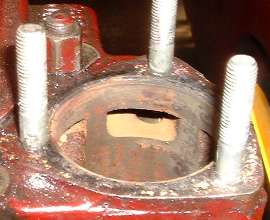
Thermostat bypass port
|
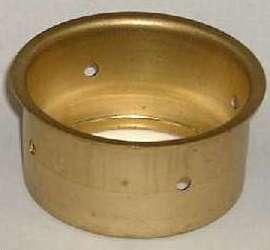
Thermostat blanking sleeve
|

 The MGA was originally designed to run with a deeper thermostat (and radiator cap for that matter) than current types.
A modern shallow thermostat will leave the bypass port in the head uncovered when the thermostat has opened (once the engine has reached normal operating temperatures), resulting in some coolant bypassing the radiator. A ‘blanking sleeve’ is available (cheaply) from most MG parts suppliers, which counteracts this by partly covering the bypass port in the head. By fitting the blanking sleeve together with a thermostat, the cooling losses imposed by the shorter current thermostats can be overcome. The MGA was originally designed to run with a deeper thermostat (and radiator cap for that matter) than current types.
A modern shallow thermostat will leave the bypass port in the head uncovered when the thermostat has opened (once the engine has reached normal operating temperatures), resulting in some coolant bypassing the radiator. A ‘blanking sleeve’ is available (cheaply) from most MG parts suppliers, which counteracts this by partly covering the bypass port in the head. By fitting the blanking sleeve together with a thermostat, the cooling losses imposed by the shorter current thermostats can be overcome.
Coolant Recovery System:
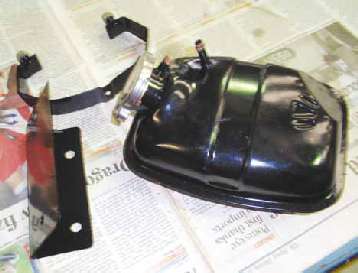
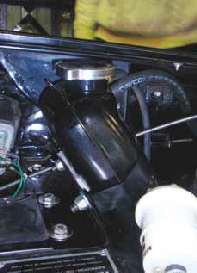
‘Rubber Bumper’ MGB sourced (used) recovery reservoir, related fitting
strap and fabricated bracket for mounting to the MGA heater shelf
|

 The MGA radiator filler neck and top tank is such that it is impossible to see the radiator water level. One therefore continually refills the radiator, only to experience the inevitable (and attention generating) coolant dump onto the ground of the now expanded circulating fluid volume after switching off after reaching normal operating temperatures. While in the MGB the system seems ‘to find its own level’, my impression is that an MGA tends to continue to dump that little bit more, (probably as a result of the MGA tending to often run at higher temperatures than an MGB). The MGA radiator filler neck and top tank is such that it is impossible to see the radiator water level. One therefore continually refills the radiator, only to experience the inevitable (and attention generating) coolant dump onto the ground of the now expanded circulating fluid volume after switching off after reaching normal operating temperatures. While in the MGB the system seems ‘to find its own level’, my impression is that an MGA tends to continue to dump that little bit more, (probably as a result of the MGA tending to often run at higher temperatures than an MGB).
 Most modern cars are fitted with a closed ‘coolant recovery system’, whereby the expanded water overflows into a separate tank. As the water cools, it is drawn back into the radiator. It is possible to tailor such a system for the MGA. Most modern cars are fitted with a closed ‘coolant recovery system’, whereby the expanded water overflows into a separate tank. As the water cools, it is drawn back into the radiator. It is possible to tailor such a system for the MGA.
Oil Coolers:
 MG themselves offered two optional oil coolers for the MGA, a 10 row cooler and a 4 row but much wider “competition” oil cooler. Both were mounted on the duct panel, ahead of the radiator, the competition cooler very forward, virtually just behind the grille. The 10 row cooler became a standard fitting for export markets during the production run of the Mk-II. MG themselves offered two optional oil coolers for the MGA, a 10 row cooler and a 4 row but much wider “competition” oil cooler. Both were mounted on the duct panel, ahead of the radiator, the competition cooler very forward, virtually just behind the grille. The 10 row cooler became a standard fitting for export markets during the production run of the Mk-II.
 There is no doubt that an oil cooler confers a measure of oil cooling when fitted. The principal benefit derived however is most likely the maintenance of adequate oil pressure during arduous and heavy load conditions, such as racing, towing and longer steep uphill gradients, particularly in high ambient temperatures. They however probably contribute only a little to overall engine cooling. Some maintain that with modern oils an oil cooler provides no additional benefit. There is no doubt that an oil cooler confers a measure of oil cooling when fitted. The principal benefit derived however is most likely the maintenance of adequate oil pressure during arduous and heavy load conditions, such as racing, towing and longer steep uphill gradients, particularly in high ambient temperatures. They however probably contribute only a little to overall engine cooling. Some maintain that with modern oils an oil cooler provides no additional benefit.
 For cooler climate use, should an oil cooler be installed, it ideally should have an in-line thermostat fitted; these are available. For cooler climate use, should an oil cooler be installed, it ideally should have an in-line thermostat fitted; these are available.
 As long as the oil cooler is mounted well forward of the radiator, it probably confers no practical impediment to oncoming air flow to the radiator behind, since the dominant difficulty in MGA radiator airflow appears to be the flow of air through the core and thereafter allowing this air to escape from behind the radiator after having passed through it. Without doubt however an oil cooler mounted close in front of the radiator would cause an element of air flow blanking to the radiator. It would also preclude the fitting of an electric “pusher fan” ahead of the radiator should the owner wish to use one. As long as the oil cooler is mounted well forward of the radiator, it probably confers no practical impediment to oncoming air flow to the radiator behind, since the dominant difficulty in MGA radiator airflow appears to be the flow of air through the core and thereafter allowing this air to escape from behind the radiator after having passed through it. Without doubt however an oil cooler mounted close in front of the radiator would cause an element of air flow blanking to the radiator. It would also preclude the fitting of an electric “pusher fan” ahead of the radiator should the owner wish to use one.
 The picture below illustrates how fitting an oil cooler may cause problems should the cooler be fitted close to the radiator. It also illustrates why the factory installation routed the oil pipes through the duct panel below the cooler. The picture below illustrates how fitting an oil cooler may cause problems should the cooler be fitted close to the radiator. It also illustrates why the factory installation routed the oil pipes through the duct panel below the cooler.
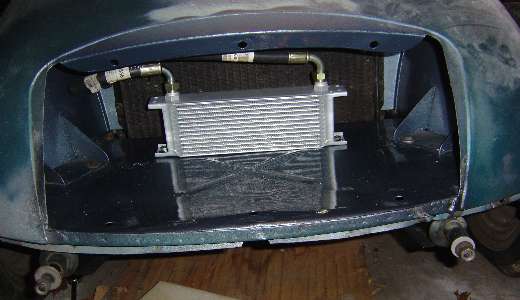
 An oil cooler of course can also be mounted under the duct panel, but should that location be adopted, ideally the valence panel would require an opening be created ahead of the cooler to enable air flow to the cooler. There would then still remain the issue of the air flow obstruction from the number/license plate and bumper bar ahead. An oil cooler of course can also be mounted under the duct panel, but should that location be adopted, ideally the valence panel would require an opening be created ahead of the cooler to enable air flow to the cooler. There would then still remain the issue of the air flow obstruction from the number/license plate and bumper bar ahead.
Whether you’re talking power or cooling, ‘There Ain’t No Substitute For Cubic (or Square) Inches’ Department:
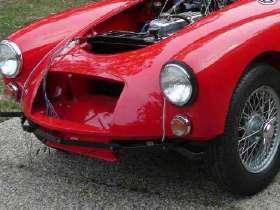

 One line of thought consists of forcing a greater volume of air through the MGA frontal aperture. One way to achieve this is by ‘opening up’ the surface area afforded by the standard grille, as done by Ian Cowan in Queensland, Australia. By creating an intake below the front bumper bar, and angling down the normally horizontal duct panel to collect this additional captured air, Ian has been able to achieve satisfactory operating temperatures despite also fitting an air conditioning condenser. Most owners however would prefer not to visibly modify their MGA to accommodate such ‘radical surgery’. One line of thought consists of forcing a greater volume of air through the MGA frontal aperture. One way to achieve this is by ‘opening up’ the surface area afforded by the standard grille, as done by Ian Cowan in Queensland, Australia. By creating an intake below the front bumper bar, and angling down the normally horizontal duct panel to collect this additional captured air, Ian has been able to achieve satisfactory operating temperatures despite also fitting an air conditioning condenser. Most owners however would prefer not to visibly modify their MGA to accommodate such ‘radical surgery’.
 To continue the above referred-to induction volume analogy, an alternative to increasing the intake frontal surface area is ‘forced induction’, in the form of an electric fan, usually as a ‘pusher fan’ mounted in front of the radiator, generally mounted in tandem with the standard engine driven fan. This arrangement can be of great assistance in standing and slow speed situations, but the benefit of an electric auxiliary fan (and the engine driven fan) tends to become negligible once the forward road speeds become adequate to generate air flow equal to or in excess of that generated by the fan/fans. To continue the above referred-to induction volume analogy, an alternative to increasing the intake frontal surface area is ‘forced induction’, in the form of an electric fan, usually as a ‘pusher fan’ mounted in front of the radiator, generally mounted in tandem with the standard engine driven fan. This arrangement can be of great assistance in standing and slow speed situations, but the benefit of an electric auxiliary fan (and the engine driven fan) tends to become negligible once the forward road speeds become adequate to generate air flow equal to or in excess of that generated by the fan/fans.
 Now onto other, specific solutions: Now onto other, specific solutions:
1) Rising Water Temperatures when idling:
 It is very neatly possible to maximize the engine driven cooling fan’s ability to draw air through the radiator core by fitting a radiator shroud. (Virtually all modern cars have these fitted). The shroud ensures that the fan can ‘suck’ fresh air across the entire core surface, not just as far as the (circular) blade arc covers the (rectangular) radiator, thereby missing the four corners of the core. The close fit of the shroud also stops air ‘rolling off’ the blade ends and going round again, and also stops stray hot engine bay air already behind the radiator getting between the fan and the radiator’s back surface, getting wastefully drawn back again. Speaking from personal experience, a shroud makes for a dramatic improvement in hot idling cooling performance. One can very obviously feel and hear the additional volume of air being sucked through the core when one of these is fitted. VERY HIGHLY RECOMMENDED. It is very neatly possible to maximize the engine driven cooling fan’s ability to draw air through the radiator core by fitting a radiator shroud. (Virtually all modern cars have these fitted). The shroud ensures that the fan can ‘suck’ fresh air across the entire core surface, not just as far as the (circular) blade arc covers the (rectangular) radiator, thereby missing the four corners of the core. The close fit of the shroud also stops air ‘rolling off’ the blade ends and going round again, and also stops stray hot engine bay air already behind the radiator getting between the fan and the radiator’s back surface, getting wastefully drawn back again. Speaking from personal experience, a shroud makes for a dramatic improvement in hot idling cooling performance. One can very obviously feel and hear the additional volume of air being sucked through the core when one of these is fitted. VERY HIGHLY RECOMMENDED.
 One note of caution in the use of radiator shrouds however needs to be made. It is important to obtain the full benefit of such a shroud, that all GAPS between the shroud and the radiator be ELIMINATED. It is much ‘easier’ for the fan to suck through such a gap (or gaps) than through the radiator core. Even a small gap or two can lead to a surprisingly significant impairment in the fan related air flow benefits that a shroud can provide in stationary conditions. One note of caution in the use of radiator shrouds however needs to be made. It is important to obtain the full benefit of such a shroud, that all GAPS between the shroud and the radiator be ELIMINATED. It is much ‘easier’ for the fan to suck through such a gap (or gaps) than through the radiator core. Even a small gap or two can lead to a surprisingly significant impairment in the fan related air flow benefits that a shroud can provide in stationary conditions.
 A radiator shroud however does not appear to confer any cooling benefit once the airflow derived as a result of the vehicle’s forward motion exceeds that generated by the fan. This probably occurs around 30mph. A radiator shroud however does not appear to confer any cooling benefit once the airflow derived as a result of the vehicle’s forward motion exceeds that generated by the fan. This probably occurs around 30mph.
2) Fuel Vaporization:
 The rather basic low tech, non-cross-flow (but surprisingly effective) B-series head has, by virtue of its layout the hottest part of the engine, the exhaust manifold, running directly below the carburettors. As a result there is an unavoidable tendency for radiant heat to directly heat the incoming fuel in the bowls. With the additional issues of high under-bonnet temperatures, cramped airspace and poor airflow in hot idling conditions, and the heating of the inlet manifold by direct thermal conduction from the cylinder head, the fuel can tend to vaporize. This problem can be further exacerbated nowadays by the requirement in many countries The rather basic low tech, non-cross-flow (but surprisingly effective) B-series head has, by virtue of its layout the hottest part of the engine, the exhaust manifold, running directly below the carburettors. As a result there is an unavoidable tendency for radiant heat to directly heat the incoming fuel in the bowls. With the additional issues of high under-bonnet temperatures, cramped airspace and poor airflow in hot idling conditions, and the heating of the inlet manifold by direct thermal conduction from the cylinder head, the fuel can tend to vaporize. This problem can be further exacerbated nowadays by the requirement in many countries
| |
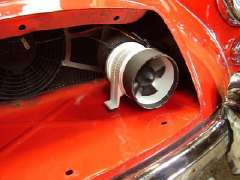
Lindsay Sampford’s
“bilge blower fan” (UK)
|
that at least 10% of fuel be ethanol based. For this reason it is imperative that the carburettor heat shield be fitted, and lined with insulating material. Many have experimented with different heat shield insulating materials, dual parallel heat shields, and even, fitted a fan (such as a four inch diameter marine application bilge blower fan) into the carburettor cool air duct, to turn on manually, in provocative conditions. Such a fan can be very effective indeed in combating fuel vaporization in such situations.
Evans Waterless Coolant:
 Much attention has been given to this product recently. However there is no evidence that the product lowers engine operating temperatures. In fact in a very well conducted trial recently in the US (admittedly on a large diesel engine fitted truck) the product showed statistically significant increased coolant temperature readings (approximately 7.25% overall) and a (statistically insignificant) rise in engine oil temperature (2.8%). Both elements are obviously undesirable in a vehicle where adequate engine cooling in many circumstances is already an issue. Much attention has been given to this product recently. However there is no evidence that the product lowers engine operating temperatures. In fact in a very well conducted trial recently in the US (admittedly on a large diesel engine fitted truck) the product showed statistically significant increased coolant temperature readings (approximately 7.25% overall) and a (statistically insignificant) rise in engine oil temperature (2.8%). Both elements are obviously undesirable in a vehicle where adequate engine cooling in many circumstances is already an issue.
www.evanscoolant.com/assets/Uploads/EvansFinal-Report05022012Deliverable.pdf
 An additional disadvantage would include power loss due to the increased drag conferred by the higher viscosity of this product compared to water, with or without coolant. So while Evans Coolant may perhaps have a role in some modern engines, it definitely appears a completely inappropriate choice for our various classic MGs. An additional disadvantage would include power loss due to the increased drag conferred by the higher viscosity of this product compared to water, with or without coolant. So while Evans Coolant may perhaps have a role in some modern engines, it definitely appears a completely inappropriate choice for our various classic MGs.
Radiators
Conventional Three, Four (and Five!) core radiators:
 When the MGA was in production, the fitted radiator was a ‘cell core’ (also known as “v-cell”) design. These cores were an intrinsically more ‘open weave’ design, and less restrictive to air flow-through. Such cores are no longer readily available. (The author has been able to locate just two current sources for such cell core radiator cores worldwide. One is located in Maine, USA, the other is in New Zealand. Contact details are listed at the end of the article). However their design probably suited the crowded engine bay of the MGA better, and may at least partly explain why high operating temperatures in an MGA appears to be a more recent issue. More modern conventional radiator cores have a denser matrix, more restrictive to air flow. When the MGA was in production, the fitted radiator was a ‘cell core’ (also known as “v-cell”) design. These cores were an intrinsically more ‘open weave’ design, and less restrictive to air flow-through. Such cores are no longer readily available. (The author has been able to locate just two current sources for such cell core radiator cores worldwide. One is located in Maine, USA, the other is in New Zealand. Contact details are listed at the end of the article). However their design probably suited the crowded engine bay of the MGA better, and may at least partly explain why high operating temperatures in an MGA appears to be a more recent issue. More modern conventional radiator cores have a denser matrix, more restrictive to air flow.
 As for such modern conventional radiators, whilst logic would suggest ‘the more rows the better’, as is so often the case, things are not always as simple as they might first appear. Certainly a four-row instead of a three-row radiator will hold 33% more coolant in the core. As a result, one would imagine it
would consequently ‘cool 33% better’. However, each subsequent radiator row will receive progressively hotter air, making each additional row less effective at heat dissipation. What’s more, with a typical staggered row radiator, each additional row adds further restriction to the passage of the cooling air through the core. To take things to a ridiculous, but illustrative extreme, a twenty row radiator would likely be close to useless! It appears that getting air THROUGH and away from the radiator is the problem in an MGA. In fact, Bob West, a highly respected West Yorkshire MGA specialist, advocates a three-row non-staggered tube radiator! Those who’ve fitted his radiator claim excellent results. Such reports however are all thus far confined to the UK, and unfortunately I suspect our British counterparts can’t even begin to imagine just how hot conditions in other parts of the globe can be. As for such modern conventional radiators, whilst logic would suggest ‘the more rows the better’, as is so often the case, things are not always as simple as they might first appear. Certainly a four-row instead of a three-row radiator will hold 33% more coolant in the core. As a result, one would imagine it
would consequently ‘cool 33% better’. However, each subsequent radiator row will receive progressively hotter air, making each additional row less effective at heat dissipation. What’s more, with a typical staggered row radiator, each additional row adds further restriction to the passage of the cooling air through the core. To take things to a ridiculous, but illustrative extreme, a twenty row radiator would likely be close to useless! It appears that getting air THROUGH and away from the radiator is the problem in an MGA. In fact, Bob West, a highly respected West Yorkshire MGA specialist, advocates a three-row non-staggered tube radiator! Those who’ve fitted his radiator claim excellent results. Such reports however are all thus far confined to the UK, and unfortunately I suspect our British counterparts can’t even begin to imagine just how hot conditions in other parts of the globe can be.
Aluminium Radiators:
 A source of much debate and argument has been the potential benefits of aluminium radiators of more modern design as an alternative to the traditional types. Some argue that copper conducts heat better than aluminium. However, the construction of radiators in aluminium allows for finer fin thickness, yielding potentially a greater surface area for heat dissipation by allowing for more but thinner fins in the same area. Other more recent radiator design concepts, such as a ‘three pass’ design (overcoming the tendency for more sluggish water flow at the lateral edges of the radiator, though at the cost of greater water flow resistance) and dimple tubes (which maximize water contact with the tube sides) further enhance the ability of the core to dump heat from the coolant in a radiator of the same physical size. A source of much debate and argument has been the potential benefits of aluminium radiators of more modern design as an alternative to the traditional types. Some argue that copper conducts heat better than aluminium. However, the construction of radiators in aluminium allows for finer fin thickness, yielding potentially a greater surface area for heat dissipation by allowing for more but thinner fins in the same area. Other more recent radiator design concepts, such as a ‘three pass’ design (overcoming the tendency for more sluggish water flow at the lateral edges of the radiator, though at the cost of greater water flow resistance) and dimple tubes (which maximize water contact with the tube sides) further enhance the ability of the core to dump heat from the coolant in a radiator of the same physical size.

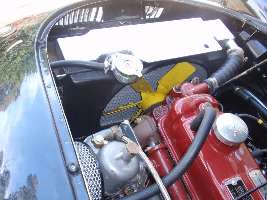
Above: Bare aluminum radiator. -- Below: Painted black for more subtle appearance.

|
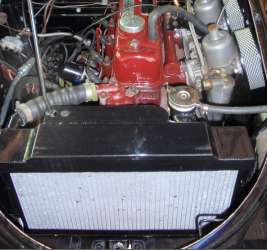
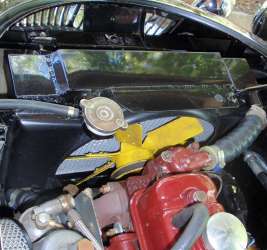
 Based on the writer’s recent personal experiences having fitted a 42mm dimple tube single pass core aluminium radiator to his own car, the cooling benefits over a standard three-row core radiator have proven to be massive (up to 30F cooler water temperatures!) in all but ‘traffic jam’ conditions in higher ambient temperatures, (30-35C; 85-95F) with no alteration other than to change over the radiators. (The original radiator had been dismantled and confirmed to be clear by a local radiator works). In the above mentioned traffic jams in hot weather, the aluminium radiator still further improved on the conventional radiator’s performance, but with less dramatic differences than those seen in all other driving circumstances. (I’ve not therefore needed to fit an electric fan to my MGA.) Based on the writer’s recent personal experiences having fitted a 42mm dimple tube single pass core aluminium radiator to his own car, the cooling benefits over a standard three-row core radiator have proven to be massive (up to 30F cooler water temperatures!) in all but ‘traffic jam’ conditions in higher ambient temperatures, (30-35C; 85-95F) with no alteration other than to change over the radiators. (The original radiator had been dismantled and confirmed to be clear by a local radiator works). In the above mentioned traffic jams in hot weather, the aluminium radiator still further improved on the conventional radiator’s performance, but with less dramatic differences than those seen in all other driving circumstances. (I’ve not therefore needed to fit an electric fan to my MGA.)
 Note: Having completed trialling this aluminium radiator, it has since been painted black, rendering it less obvious. However, eliminating gaps between the shroud and the radiator was much easier with the natural alloy against the black shroud. Note: Having completed trialling this aluminium radiator, it has since been painted black, rendering it less obvious. However, eliminating gaps between the shroud and the radiator was much easier with the natural alloy against the black shroud.
Summary:
 The MGA does manifest engine cooling issues in warmer ambient temperatures (as a cursory perusal of most MGA forums amply demonstrates). This does appear to a large part to be due to the relatively cramped MGA engine bay. It however is possible to compensate for this. The MGA does manifest engine cooling issues in warmer ambient temperatures (as a cursory perusal of most MGA forums amply demonstrates). This does appear to a large part to be due to the relatively cramped MGA engine bay. It however is possible to compensate for this.
 The author has found after extensive experimentation with his own car, that the dominant improvements were achieved with a radiator shroud and a more efficient radiator (in this case a custom made aluminium radiator). As a result the writer’s MGA now operates in a very comfortable range no matter what the traffic conditions and ambient temperature. A number of other often seen aids and modifications, such as supplementary electric fans, have proven to be unnecessary. The author has found after extensive experimentation with his own car, that the dominant improvements were achieved with a radiator shroud and a more efficient radiator (in this case a custom made aluminium radiator). As a result the writer’s MGA now operates in a very comfortable range no matter what the traffic conditions and ambient temperature. A number of other often seen aids and modifications, such as supplementary electric fans, have proven to be unnecessary.
 The cost of the modifications used to achieve such satisfactory cooling have ranged from just a few dollars (e.g. blanking sleeve and under-bonnet air dam) to about $800 (UK pounds 520) for the custom built aluminium radiator. The cost of the modifications used to achieve such satisfactory cooling have ranged from just a few dollars (e.g. blanking sleeve and under-bonnet air dam) to about $800 (UK pounds 520) for the custom built aluminium radiator.
Useful contacts:
 PWR who supplied my custom aluminium radiator. They export worldwide regularly (in fact the majority of their product is for export). PWR who supplied my custom aluminium radiator. They export worldwide regularly (in fact the majority of their product is for export).
www.pwr.com.au/#/view=home/
 Cell core radiators are available in the US from Maine radiators. They however will not sell to individuals, only to radiator manufacturers and suppliers. Cell core radiators are available in the US from Maine radiators. They however will not sell to individuals, only to radiator manufacturers and suppliers.
www.maineradiator.com
 The New Zealand manufacturers of cell core radiator cores will supply to individuals, and are happy to export worldwide: The New Zealand manufacturers of cell core radiator cores will supply to individuals, and are happy to export worldwide:
www.radiators.co.nz/radiator-products
I believe they are a very pleasant and helpful firm to deal with.
| MODIFICATION |
Benefit
(1: minor benefit, to
5: major benefit)
|
Fitting ease
(1: easy installation
to 5: difficult)
|
Cost
(1: <$50 to
5: >$1000)
|
Replace original blanking around radiator
|
2
|
1
|
1
|
Cylinder head blanking sleeve
|
2
|
1
|
1
|
Coolant recovery system
|
3
|
2
|
2
|
Increased frontal aperture
|
3
|
5
|
5
|
Bonnet Louvres (position dependent)
|
2
|
5
|
5
|
Under-tray
|
1
|
3
|
3
|
Supplementary electric fan/s
|
3
|
3
|
3
|
Carburettor air duct fan *
|
3
|
2
|
2
|
Radiator shroud
|
4
|
2
|
2
|
Cell core, or, aluminium radiator
|
5
|
2
|
4
|
Oil Cooler
|
2
|
3
|
3
|
Evans’ Waterless Coolant
|
-2
|
1
|
1
|
* Note: Carburettor air duct fan has significant fuel vaporisation reduction benefit, but no coolant/running temperature benefit.
|










